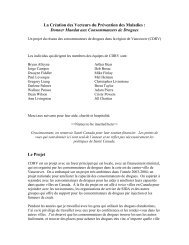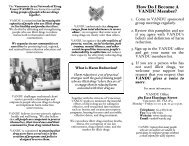The Injection Support Team - Vancouver Area Network of Drug Users
The Injection Support Team - Vancouver Area Network of Drug Users
The Injection Support Team - Vancouver Area Network of Drug Users
You also want an ePaper? Increase the reach of your titles
YUMPU automatically turns print PDFs into web optimized ePapers that Google loves.
494 W. SMALL ET AL.<br />
Subst Use Misuse Downloaded from informahealthcare.com by University <strong>of</strong> British Columbia on 03/28/12<br />
For personal use only.<br />
RESULTS<br />
<strong>The</strong> following analysis presents data generated through<br />
the various research activities in order to detail the origins<br />
and objectives <strong>of</strong> the IST, the organization and operation<br />
<strong>of</strong> the <strong>Team</strong>, and the perspectives <strong>of</strong> the individuals who<br />
receive support from the IST.<br />
<strong>The</strong> Origin <strong>of</strong> the IST<br />
<strong>The</strong> IST began operating in August 2005, and its formation<br />
represents a drug-user-led response to ongoing harms<br />
associated with unsafe and assisted injecting, as well as<br />
the limitations <strong>of</strong> the recently established SIF. A primary<br />
rationale for the formation <strong>of</strong> the IST was to provide education<br />
regarding safer assisted-injection and instruction<br />
on how to self-inject to injectors who require this type <strong>of</strong><br />
guidance due to a lack <strong>of</strong> knowledge <strong>of</strong> injection techniques.<br />
<strong>The</strong> IST Mission Statement emphasizes the basic<br />
principles <strong>of</strong> the program:<br />
<strong>The</strong> VANDU <strong>Injection</strong> <strong>Support</strong> <strong>Team</strong> is a user-led program that<br />
provides peer-to-peer education and assistance to promote safer injecting<br />
practices. Through advocacy and outreach the IST seeks to<br />
reduce the harms resulting from unsafe injection and preserve the<br />
health <strong>of</strong> injection drug users.<br />
Targeting the health consequences <strong>of</strong> unsafe injecting,<br />
primarily HIV infection as well as other serious complications<br />
including amputation and death, was a key motivation<br />
for forming the IST:<br />
We saw a lot <strong>of</strong> people really harming themselves in the neighborhood.<br />
People were shooting dope, and they were missing their veins,<br />
and they were having abscesses, and the abscesses were getting really<br />
bad, and they might have to have the arm amputated or cut <strong>of</strong>f.<br />
You see a lot <strong>of</strong> people with missing limbs, and that’s usually what<br />
it’s caused by down here. (IST member)<br />
In order to address unsafe injection practices and the<br />
resultant health complications, the <strong>Team</strong> formed as a vehicle<br />
to provide safer injection education within the open<br />
drug scene and to target individuals who were participating<br />
in public injecting. In this regard, the IST bears some<br />
similarities to previous VANDU programs including the<br />
Alley Patrol and the unsanctioned SIF, as both <strong>of</strong> these<br />
initiatives sought to address the risks associated with public<br />
injection settings. While there is an element <strong>of</strong> continuity<br />
between the IST and these previous activities, the<br />
IST places greater emphasis upon safer injecting education<br />
and has an explicit focus on addressing the harms<br />
stemming from assisted injection.<br />
<strong>The</strong> group <strong>of</strong> individual VANDU members that formed<br />
the IST all had previous experience providing assisted injections,<br />
as they were established “hit doctors” in the local<br />
injecting scene. <strong>The</strong> team was initially composed <strong>of</strong><br />
12 members who each had more than 10 years experience<br />
injecting drugs and who were regularly sought out to provide<br />
assisted injections by members <strong>of</strong> the local drug user<br />
community.<br />
So I’ve been helping people for 25, 30 years—that’s what all the<br />
team was. All <strong>of</strong> us had ...years <strong>of</strong> [experience] injecting ...and<br />
were really trusted out in the community, and trusted by their peers.<br />
(IST member)<br />
<strong>The</strong> social identity <strong>of</strong> the founding team members permitted<br />
the IST to build on the important drug scene role<br />
that “doctors” play and afforded opportunities to raise<br />
awareness <strong>of</strong> the hazards related to assisted injecting.<br />
<strong>Team</strong> members discussed the need to encourage those receiving<br />
injections to recognize that someone else’s actions<br />
shape the potential for drug-related harm when individuals<br />
who receive injections relinquish control <strong>of</strong> the injection<br />
process:<br />
We’ve seen people in the alley going, “Can anybody fix me?” That<br />
“anybody” doesn’t really care...(IST member)<br />
Another primary motivation leading to the formation<br />
<strong>of</strong> the IST relates to the systematic barriers to accessing<br />
the SIF stemming from the prohibition on assisted<br />
injections. Due to these regulations, individuals who require<br />
help injecting were unable to access the facility and<br />
were compelled to seek the assistance <strong>of</strong> “hit doctors” outside<br />
<strong>of</strong> the facility. <strong>The</strong> <strong>Team</strong> members recognized that a<br />
large number <strong>of</strong> assisted injections were occurring within<br />
public injecting venues. <strong>The</strong> failure <strong>of</strong> the SIF to accommodate<br />
some <strong>of</strong> the most vulnerable and marginalized injectors,<br />
those who rely on assisted injections, was another<br />
motivation for forming the IST.<br />
People that can’t fix themselves can’t go to the safe site (SIF), right.<br />
You see people ...somebody is fixing somebody right in the alley.<br />
(IST member)<br />
A particular incident, which occurred in early 2005,<br />
was frequently discussed as being an important factor in<br />
the formation <strong>of</strong> the IST. A female VANDU member with<br />
a physical disability, who was unable to self-inject and relied<br />
on others to administer her injections, had arranged an<br />
assisted injection for a small fee when she was assaulted<br />
and robbed in the alley behind the SIF by the “doctor.”<br />
For <strong>Team</strong> members, this event highlighted the hazards <strong>of</strong><br />
assisted injection in the open drug scene and the inability<br />
<strong>of</strong> the SIF to address the risks related to this practice.<br />
<strong>The</strong> incident also served as a catalyst for particular members<br />
<strong>of</strong> VANDU to take action and develop strategies to<br />
address the problem. With regard to the limitations <strong>of</strong> the<br />
SIF, highlighting the shortcomings <strong>of</strong> current regulations<br />
and “forcing” the SIF to permit either nurse-assisted or<br />
peer-assisted injection within the facility was another goal<br />
influencing the formation <strong>of</strong> the <strong>Team</strong>.<br />
<strong>Team</strong> Organization and Processes<br />
<strong>The</strong> IST engages with users through outreach activities,<br />
where two <strong>Team</strong> members spend 2–3 hours in the open<br />
drug scene, 5 days a week. All IST members have received<br />
training in CPR (cardiopulmonary resuscitation),<br />
first aid, overdose recognition, and instruction regarding<br />
the delivery <strong>of</strong> safer injection education. In addition, the<br />
<strong>Team</strong> has developed a manual <strong>of</strong> operational procedures<br />
and protocols, which inform outreach activities. During<br />
outreach, the <strong>Team</strong> distributes a range <strong>of</strong> harm reduction





